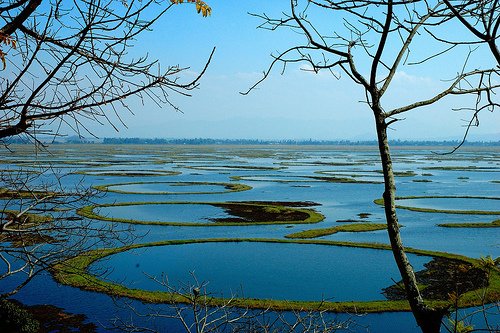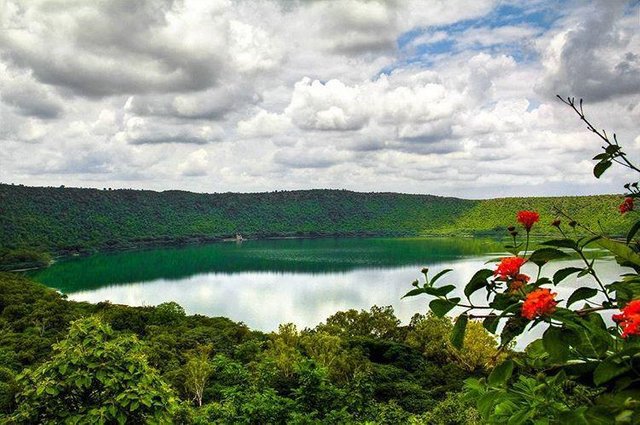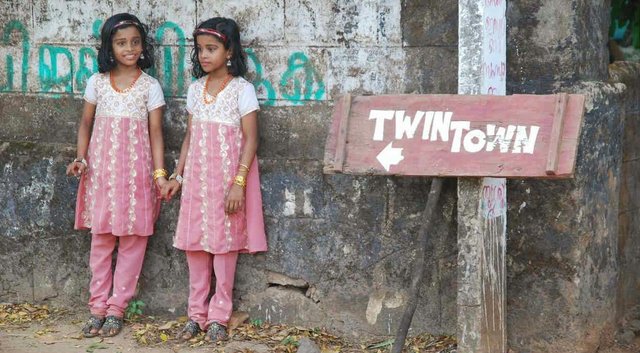- Only floating lake :

Img src : "http://cdn.walkthroughindia.com/wp-content/uploads/2010/07/loktak-lake"
The Loktak Lake is the largest freshwater lake in North East India located 50 Kms from Imphal, in the State of Manipur, famed for the shimmering blue water, labyrinthine boat routes, colourful water plants and the enigmatic phumdis.
Phumdis is an accrual of decay of organic garbage, soil particles thickened into a assorted mix of vegetation, soil and organic matter. During the rainy season the phumdis floats on the water and in the dry season it sinks to the bottom, with the roots deriving its nutrients from the soil, thereby ensuring survival of the biomass.
However with the installation of the Loktak Hydroelectric Project the water levels remain high all around the year. This has created disturbance in the feeding of nutrients on lake bottom by the phumdis and hence lead to a loss of biomass and thinning of the islands with each passing year. In the process two ecological systems have formed in the Loktak Lake , one, the body of open water covering one-third of the area and the other, the phumbi covering the remaining two-third.
- Lake of skeletons :

Img src : " "
"
Lake Roopkund is located in northern India along the border of Nepal at 4,800 meters (~16,000 ft) above sea level with edges covered in snow for most of the year. The water is rather shallow, only reaching a maximum depth of 2 meters, and frozen most of the year. The frozen climate at this altitude has aided significantly in the preservation of hair, soft tissue, and leather clothing, prompting the everyone to believe these were recent deaths. These skeletons were initially thought to be the bodies of Japanese soldiers who had died of exposure while travelling through India as part of a World War II invasion. More recent analyses conclude the remains were much older than anyone expected, dating them to approximately 850AD.
The significant amounts of soft tissue present first confused everyone. How could these skeletons be old if there was still flesh on the bones?
Who were these people? DNA evidence of the remains indicates there were two distinct groups – (1) a closely related or family group, and (2) a shorter group of local people, likely hired as porters and guides. Many artifacts (spears, leather shoes, rings, etc.) were found among remains, leading experts to conclude the family group was most likely made up of pilgrims heading through the valley with the help of the locals as guides.
What happened to them? It was initially proposed these people died as a result of exposure, perhaps trapped in an avalanche. But closer inspection of the bones reveals evidence of perimortem trauma on many of the skeletons. This is trauma that occurred at the time of death. Scientists apparently discovered a surprising pattern, in which the skulls and mostly bones of the upper body were inflicted with a similar type of trauma.
- Lonar crater lake :

Img src : "https://i2.wp.com/huntforspot.com/wp-content/uploads/2016/06/lonar-crater"
One of its kind phenomena on the planet is the Lonar Crater Lake with geological, geographical, mythical, scientific wonders - all served in one platter. The only hyper-velocity crater lake in the world formed from basaltic rock was created by a meteor impact some 52000 years ago and is the third largest salt water lake in the world. The mystery behind the aftermaths of the meteor impact as to why a compass fails to work in some parts of the crater, how it is able to support some rare micro-organisms that are hardly found at any other place on the planet, why is the water alkaline and saline and what lurks at the bottom of this lake make it even more intriguing.
The lake has been mentioned in some ancient scriptures such as the Skanda Purana, Padma Puran and Aina-i-Akbari. Locals believe that the town got its name Lonar after Lord Vishnu defeated the demon Lonasura. Scattered around the periphery of the lake are fifteen exquisite temples giving us a feel that they stand guard to protect the lake, barely the remains of which now stand to tell the tale of the glorious past.
- Village without doors :

Img src : "http://ichef.bbci.co.uk/wwfeatures/wm/live/1280_640/images/live/p0/3w/cl/p03wcl2t"
About 300 km east of Mumbai, in the remote Indian village of Shani Shingnapur, crime is a concept so alien that villagers here have stopped guarding their houses, their properties and their valuables. Nobody locks their cars and motorbikes anymore. Shopkeepers leave cash in unlocked drawers overnight, and housewives keep jewelry in unlocked boxes, inside houses that have no doors —just a wooden door frame with a curtain drawn across to protect the privacy of the residents. Such is the faith the villagers have on their heavenly guardian, Lord Shani, who they believe protects them from thieves. The belief, that whoever steals anything from this place will incur the wrath of Lord Shani —a Hindu god known for his mad temper and penchant for revenge— and will have to pay dearly for their sins, has kept wrong doers away from Shingnapur for the last 300 years.
- Twin town, Kerala :

Img src : "https://1.bp.blogspot.com/-dVhc04qU6Dw/U5l2wVzaDgI/AAAAAAAABcg/x96mPdXUrLI/s1600/Kodinhi13"
Sometimes mysteries hide in plain sight. Like the tall pyramids of Egypt or the Stonehenge of England. But some mysteries and curiosities are hidden and have to be found and dug out. One such lies right in our backyard, Kerala. There’s a small village in Kerala called Kodinhi. Sounds simple and straight forward, but it’s in fact a strange little town.
Did we catch your attention? Are you curious enough? Read on to find out why all is not what it seems like in this village.
The mystery of Kodinhi
A small village, Kodinhi is home to just 2000 families, but here’s the strange part, this village recently came under international attention for having the most number of twin births. The village of Kodinhi is filled with twins.
Kodinhi, Twin Town of Kerala
India has one of the lowest twinning rates in the world, yet this village is known to have a high twinning rate. A research conducted disclosed that there are around 204 pairs of twins, and to make things stranger, most of them are identical. The strangeness of the tale doesn’t end here, but takes another turn into weird town. Some of the women of this village have married into far off villages and tribes, they too have been known to give birth to twins.
Congratulations! This post has been upvoted from the communal account, @minnowsupport, by pratique007 from the Minnow Support Project. It's a witness project run by aggroed, ausbitbank, teamsteem, theprophet0, someguy123, neoxian, followbtcnews/crimsonclad, and netuoso. The goal is to help Steemit grow by supporting Minnows and creating a social network. Please find us in the Peace, Abundance, and Liberty Network (PALnet) Discord Channel. It's a completely public and open space to all members of the Steemit community who voluntarily choose to be there.
If you would like to delegate to the Minnow Support Project you can do so by clicking on the following links: 50SP, 100SP, 250SP, 500SP, 1000SP, 5000SP. Be sure to leave at least 50SP undelegated on your account.
Downvoting a post can decrease pending rewards and make it less visible. Common reasons:
Submit